#Allosauroidea
Explore tagged Tumblr posts
Text
Allosaurus anax Danison et al., 2024 (new species)

(Type postorbital [bone behind the eye] of Allosaurus anax, from Danison et al., 2024)
Meaning of name: anax = king [in Greek]
Age: Late Jurassic (Kimmeridgian–Tithonian), between 145–153 million years ago
Where found: Morrison Formation, Oklahoma, U.S.A.
How much is known: A right postorbital (bone in the skull, behind the eye), two vertebrae, and some hindlimb bones. It is unknown whether any of these bones belonged to the same individuals.
Notes: A. anax is based on fossils formerly considered specimens of Saurophaganax, which was thought to be a large theropod closely related to Allosaurus. A new study finds that specimens previously assigned to Saurophaganax actually include a mix of sauropod and theropod bones. However, the authors were not able to definitively classify the type specimen of Saurophaganax (a partial vertebra) as belonging to either a sauropod or a theropod. As a result, they argue that the type specimen lacks distinguishing features that would allow additional specimens to be identified as belonging to the same genus, rendering Saurophaganax a dubious name that should not be applied to other specimens.
Furthermore, the authors found that many of the features that supposedly differentiated Saurophaganax from Allosaurus came from the sauropod specimens once included in the genus Saurophaganax. When only the definitive theropod bones are considered among the former Saurophaganax material, the authors deem it most likely that these fossils represent specimens of Allosaurus. Nonetheless, some of the theropod bones exhibit minor differences from previously recognized species of Allosaurus, such as by being larger (belonging to animals estimated to have weighed over 3.5 tons) and lacking a rough texture on the postorbital. The authors thus classify these fossils as a new species of Allosaurus, A. anax.
Reference: Danison, A.D., M.J. Wedel, D.E. Barta, H.N. Woodward, H.M. Flora, A.H. Lee, and E. Snively. 2024. Chimerism in specimens referred to Saurophaganax maximus reveals a new species of Allosaurus (Dinosauria, Theropoda). Vertebrate Anatomy Morphology Palaeontology 12: 81–114. doi: 10.18435/vamp29404
107 notes
·
View notes
Text

Neovenator head drawing.
Based on reconstruction of skull by @/DanPalaeon1 on twitter.
8 notes
·
View notes
Text
Where would you fit Megaraptorans in the dinosaur family tree?
1 note
·
View note
Text
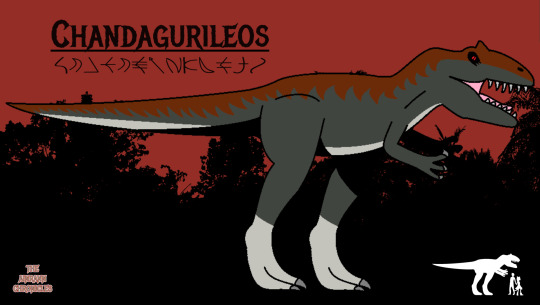
Species: Chandagurileos ("Lion of Chandaguru") Clade: Allosauroidea Diet: Carnivore Size: 30 ft Habitat: Forested Areas Threat Level: 5/5 (Very Lethal) Group Orientation: Pack Hunters Fun Facts: Unlike other large predators, Chandagurileos hunt in packs consisting of 3-6 members, but there have been reports of packs with up to 10 members. This allows them to have expansive territories, making them the most widespread member of the allosaur family. As pack hunters they also raise their young together and care for them even after they grow up, but fully grown males can go off on their own to form a new pack if they choose to. They are also extremely protective of their young, attacking and even killing any dinosaur that venture too close to their nests.
Chandagurileos can run down their prey without any problem. They are lightly built and more streamlined than other large predators, granting them greater speed over longer distances. They work together as a pack to bring down their prey and overpower it until exhaustion and blood loss takes its toll. They tend to hunt for smaller prey but will gang up to bring down large herbivores when hunting in a pack. Young Chandagurileos are effective hunters themselves, often straying from their nests to track down prey of their own.
Arkians of the Chandaguru forests come into contact with Chandagurileos more than any other southern predator. Arkians tend to be pretty easy targets, earning them a spot on the Chandagurileos' menu. The young go after them much more than the adults do and are considered more dangerous in that regard.
1 note
·
View note
Video
youtube
#Siats was large powerful #predator, IF it is what all its fragmentary parts suggest it is! Siats marks a power transition between #Allosaurs and #tyrannosaurs.
#siats#theropod#dinosaur#dino#carnivore#natural history#scicomm#science#education#paleontology#fossils#fragmentary#carcharodontosaurid#neovenatorid#allosaur#allosauroidea#allosaurus#Utah#tyrannosaurs#early cretaceous
7 notes
·
View notes
Photo
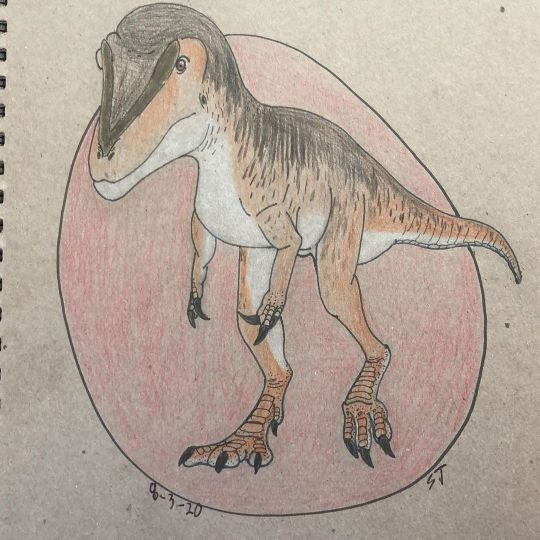
I was originally gonna do something for this country fair as of today, but now they canceled because of pandemic of 2020, that won’t even stopped me for posting #paleoart like a siats meekerorum now being more Neovenatoridae than to Megaraptoridae with more realistic versions and even more better skin colors and especially with Saurian lip. As my paleoart of siats is being better than last time since in 2013 and early 2014, now I could see it good. On the side note, I just finished up with my last two pages from my sketchbook started from last year in college’s drawing class to all away to lockdown as the start of 2020 and now then cardboard covers is easy to use to sketch, inked and colored with colored pencils. #siats #siatsmeekerorum #coloredpencil #coloredpencils #neovenatoridae #carcharodontosauria #allosauroidea #carnosauria #avetheropoda #theropoda #dinosauria #artistsoninstagram #sketchbook #myart https://www.instagram.com/p/CDcb-VPFcr1/?igshid=vculhi42pxl5
#paleoart#siats#siatsmeekerorum#coloredpencil#coloredpencils#neovenatoridae#carcharodontosauria#allosauroidea#carnosauria#avetheropoda#theropoda#dinosauria#artistsoninstagram#sketchbook#myart
2 notes
·
View notes
Text
It Came From The Wastebasket #07: Carnosaur Carnage
Carnosauria was originally named in the 1920s as a grouping for all of the large-bodied theropod dinosaurs known at the time.
For much of the 20th century it was used as a general wastebasket taxon collecting together all big carnivorous forms – including allosaurids, carcharodontosaurids, megalosaurids, spinosaurids, ceratosaurids, abelisauroids, and tyrannosaurids – and for a while it even included a species that later turned out to be closer related to crocodiles than to dinosaurs.

From left to right: Asfaltovenator vialidadi, Torvosaurus tanneri, Giganotosaurus carolinii, & Baryonyx walkeri
But then cladistic analysis in the 1980s and 1990s revealed that some of these theropods weren't actually closely related at all. Carnosaurs weren't a natural lineage but instead were highly polyphyletic, with the physical similarities between them seeming to be more due to convergent evolution than direct shared ancestry.
Some carnosaurs were split off and reclassified as more "primitive" types of theropod, while the tyrannosaurs were placed much closer to birds with the coelurosaurs. The remaining "carnosaurs" were just the allosaurids, carcharodontosaurs, and their closest relatives, and some paleontologists now prefer to use the name Allosauroidea for this group to distance it from the previous wastebasket mess.
…But Carnosauria might not be done just yet.
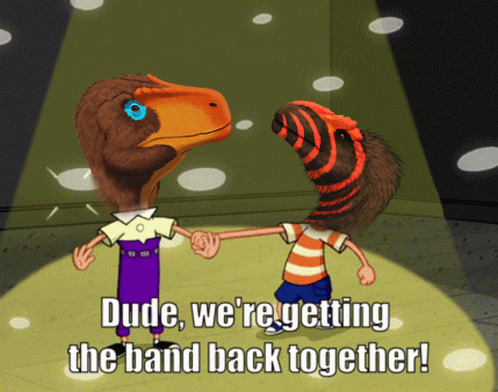
The discovery of Asfaltovenator in 2019 complicated matters once again, with a mixture of anatomical features linking it to both the allosauroids and the megalosauroids (megalosaurids, spinosaurids, and their relatives) – suggesting that these two groups might actually have been closely related to each other in a single lineage after all.
This would potentially return Carnosauria back to something surprisingly close to its original definition, with the various megalosauroids now forming an evolutionary grade leading to the allosauroids.
———
Nix Illustration | Tumblr | Twitter | Patreon
#it came from the wastebasket#wastebasket taxon#taxonomy#carnosaur#asfaltovenator#torvosaurus#giganotosaurus#baryonyx#theropod#dinosaur#paleontology#art#science illustration#paleoart#palaeoblr
339 notes
·
View notes
Photo
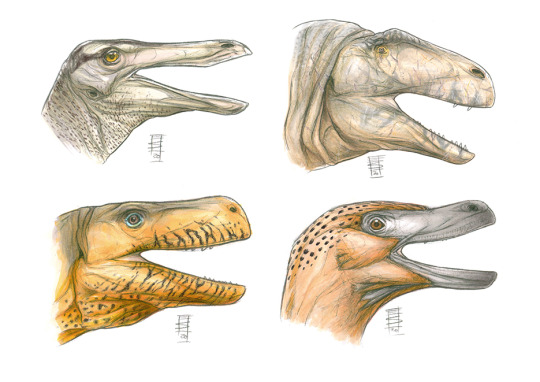
Exercise_Theropod Heads. Pencils and markers, 2020.
Top: Gallimimus (left), Acrocanthosaurus (right). Bottom: Herrerasaurus (left), Velociraptor (right).
References
Eddy DR, Clarke JA (2011) New Information on the Cranial Anatomy of Acrocanthosaurus atokensis and Its Implications for the Phylogeny of Allosauroidea (Dinosauria: Theropoda). PLoS ONE 6(3): e17932. https://doi.org/10.1371/journal.pone.0017932
Paul, G.S. 2002. Dinosaurs of the Air: the Evolution and Loss of Flight in Dinosaurs and Birds. Baltimore: Johns Hopkins University Press (Baltimore)
#paleoart#dinosaur#theropod#ornithomimosaur#gallimimus#carnosaur#acrocanthosaurus#herrerasaurus#dromaeosaur#raptor#velociraptor#pencils#markers#exercise
294 notes
·
View notes
Text
Australovenator wintonensis

By Scott Reid
Etymology: Southern Hunter
First Described By: Hocknull et al., 2009
Classification: Dinosauromorpha, Dinosauriformes, Dracohors, Dinosauria, Saurischia, Eusaurischia, Theropoda, Neotheropoda, Averostra, Tetanurae, Orionides, Avetheropoda, Megaraptora, Megaraptoridae
Status: Extinct
Time and Place: About 95 million years ago, in the Cenomanian of the Late Cretaceous

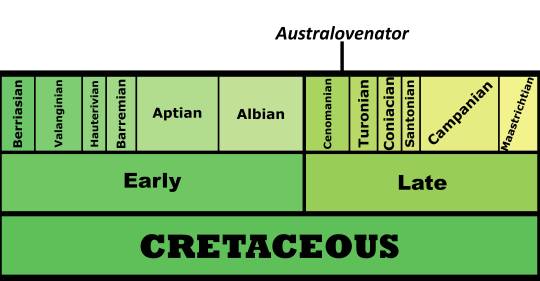
Australovenator is known from the Phimopollenites Pannosus Pollen Zone of the Winton Formation in Queensland, Australia
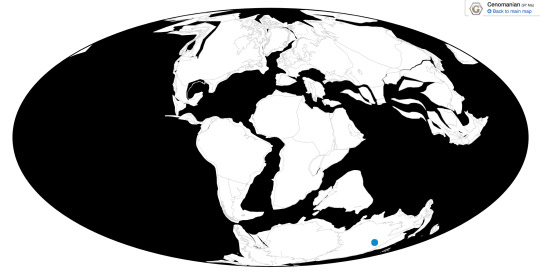
Physical Description: Australovenator was a Megaraptor, a group of fairly mysterious predatory dinosaurs that consistently confuse people since they were first discovered through today. The known parts of Australovenator are rather sparse - limbs and some parts of the torso, and a bit of the tip of the mouth. These elements show an animal with long legs, fairly long arms (for a theropod) with giant hand claws, and a slender jaw. The rest of our understanding of its size and shape is really based on its relatives. It would probably have been 6 meters long and 2 meters tall, weighing only 1,000 kilograms - making it a very lightweight, potentially fast predator. It had extremely flexible hands as well - more flexible than other theropods, almost able to pronate (ie, make “bunny hands”, which is not possible in other theropods). It also had extremely strong feet, built for kicking. Given that it was slender and small, it would have probably been covered in fluffy protofeathers all over its body.

By Ashley Patch
Diet: Australovenator would have been a major predator, able to eat a wide variety of small and medium sized animals in its environment - potentially even larger animals if it was able to work in groups.
Behavior: The behavior of Australovenator is not greatly known, given how mysterious Megaraptorans are as a general group. However, the extremely strong foot bones found with extensive signs of breakage indicates that Australovenator did use its feet to kick at prey, similar to modern emus. This would have greatly bruised and damaged the prey, potentially even breaking bones and causing internal bleeding and organ damage. The extremely flexible arms would have allowed it to use them to manipulate objects, grab at food, and easily claw at prey. In fact, the very large hand claws are notable for the Megaraptorans, since they were originally thought to be the giant foot claws of giant Dromaeosaurs. This ability to claw at and maim prey would have helped Australovenator extensively in taking down prey.
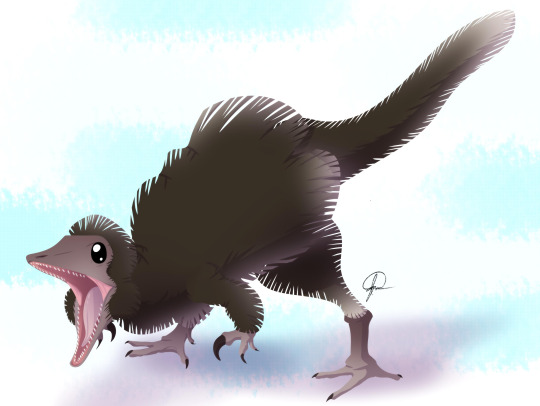
By José Carlos Cortés
Were Megaraptorans social? We aren’t sure. Australovenator was a powerful predator, clearly able to take down other animals in its environment without much help. It may have worked in small groups in order to get food larger than it, such as the sauropod Diamantinasaurus, since there weren't larger predators in its environment. However, there is no direct evidence to support that. Furthermore, in plenty of locations, Megaraptorans are very rare, indicating they wouldn’t have grouped up together much. Still, they usually aren’t the largest predators in a place, so the jury is out for Australovenator. As a dinosaur, it would have probably taken care of its young, though in what way is a question.
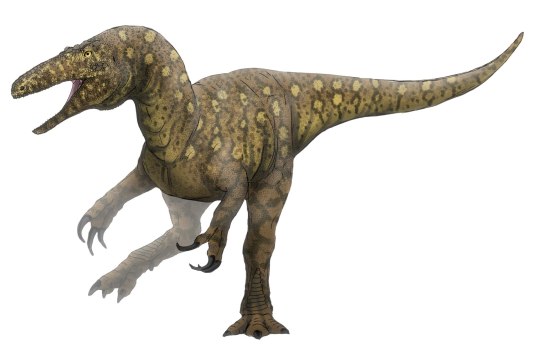
By PaleoEquii, CC BY-SA 4.0
Ecosystem: The Winton Environment was a river basin, next to the former inland Eromanga Sea. This was a highly forested ecosystem with extensive swamps, creeks, lakes, and estuaries leading back to the sea. The dense vegetation made it a hotbed for herbivores, which were all sources of prey for Australoveantor. In fact, Australovenator was found directly with Diamantinasaurus, a 15 to 16 meter long sauropod (indicating that Australovenator may have been scavenging, or worked in a group and was killed by a group member). Other herbivores included the titanosaurs Wintonotitan and Savannasaurus, and the Somphospondylian Austrosaurus. There were a variety of Ornithischians there, though none were named, they may have been Rhabdodonts or Elasmarians; and there was at least one Ankylosaur (probably a basal Ankylosaurid). In addition, there was the large pterosaur Ferrodraco, and the narrow-snouted Crocodylomorph Isisfordia.

By Ripley Cook
Other: Megaraptors like Australovenator are a taxonomical quagmire. They are either closely related to the Carnosaurs - animals like Allosaurus and Giganotosaurus - or to early Coelurosaurs such as the Tyrannosaurs. It’s possible they are Tyrannosaurs, full stop, but an early group of them. Honestly, the question is still up in the air - but they combine a lot of the characteristics of the earlier theropods with the more bird-like ones, which leads to this confusion. Regardless, Australovenator was a very late derived Megaraptor, nested deep within the group.
~ By Meig Dickson
Sources Under the Cut
Agnolin, F. L., M. D. Ezcurra, D. F. Pais and S. W. Salisbury. 2010. A reappraisal of the Cretaceous non-avian dinosaur faunas from Australia and New Zealand: evidence for their Gondwanan affinities. Journal of Systematic Palaeontology 8(2):257-300.
Apesteguía, Sebastián; Smith, Nathan D.; Valieri, Rubén Juárez; Makovicky, Peter J. (2016-07-13). "An Unusual New Theropod with a Didactyl Manus from the Upper Cretaceous of Patagonia, Argentina". PLOS ONE. 11 (7): e0157793.
Benson, R. B. J., M. T. Carrano, and S. L. Brusatte. 2010. A new clade of archaic large-bodied predatory dinosaurs (Theropoda: Allosauroidea) that survived to the latest Mesozoic. Naturwissenschaften 97:71-78.
Brougham, T., E. T. Smith, and P. R. Bell. 2019. New theropod (Tetanurae: Avetheropoda) material from the ‘mid’-Cretaceous Griman Greek Formation at Lightning Ridge, New South Wales, Australia. Royal Society Open Science 6:180826:1-18.
Carrano, M. T., R. B. J. Benson, and S. D. Sampson. 2012. The phylogeny of Tetanurae (Dinosauria: Theropoda). Journal of Systematic Palaeontology 10(2):211-300.
Csiki-Sava, Z., S. L. Brusatte, and S. Vasile. 2016. “Megalosaurus cf. superbus” from southeastern Romania: the oldest known Cretaceous carcharodontosaurid (Dinosauria: Theropoda) and its implications for earliest Cretaceous Europe-Gondwana connections. Cretaceous Research 60:221-238.
Hendrickx, C., and O. Mateus. 2014. Abelisauridae (Dinosauria: Theropoda) from the Late Jurassic of Portugal and dentition-based phylogeny as a contribution for the indentification of isolated theropod teeth. Zootaxa 3759(1):1-74.
Hocknull, S. A., M. A. White, T. R. Tischler, A. G. Cook, N. D. Calleja, T. Sloan, and D. A. Elliot. 2009. New mid-Cretaceous (latest Albian) dinosaurs from Winton, Queensland, Australia. PLoS ONE 4(7):e6190:1-51.
Holtz, Thomas R., Jr.; Molnar, Ralph E.; Currie, Philip J. (2004). Weishampel, David B.; Dodson, Peter; Halszka, Osmólska (eds.). The Dinosauria (2nd ed.). Berkeley: University of California Press. pp. 71–110.
Leahey, Lucy G.; Salisbury, Steven W. (June 2013). "First evidence of ankylosaurian dinosaurs (Ornithischia: Thyreophora) from the mid-Cretaceous (late Albian–Cenomanian) Winton Formation of Queensland, Australia". Alcheringa: An Australasian Journal of Palaeontology. 37 (2): 249–257.
Molnar, Ralph E.; Flannery, Timothy F.; Rich, Thomas H.V. (1981). "An allosaurid theropod dinosaur from the Early Cretaceous of Victoria, Australia". Alcheringa. 5 (2): 141–146.
Novas, F. E.; Agnolín, F. L.; Ezcurra, M. D.; Canale, J. I.; Porfiri, J. D. (2012). "Megaraptorans as members of an unexpected evolutionary radiation of tyrant-reptiles in Gondwana". Ameghiniana. 49 (Suppl): R33.
Pentland, Adele H.; Poropat, Stephen F.; Tischler, Travis R.; Sloan, Trish; Elliott, Robert A.; Elliott, Harry A.; Elliott, Judy A.; Elliott, David A. (December 2019). "Ferrodraco lentoni gen. et sp. nov., a new ornithocheirid pterosaur from the Winton Formation (Cenomanian–lower Turonian) of Queensland, Australia". Scientific Reports. 9 (1): 13454.
Porfiri, Juan D.; Novas, Fernando E.; Calvo, Jorge O.; Agnolín, Federico L.; Ezcurra, Martín D.; Cerda, Ignacio A. (2014). "Juvenile specimen of Megaraptor (Dinosauria, Theropoda) sheds light about tyrannosauroid radiation". Cretaceous Research. 51: 35–55.
Poropat, S.F.; Mannion, P.D.; Upchurch, P.; Hocknull, S.A.; Kear, B.P.; Kundrát, M.; Tischler, T.R.; Sloan, T.; Sinapius, G.H.K.; Elliott, J.A.; Elliott, D.A. (2016). "New Australian sauropods shed light on Cretaceous dinosaur palaeobiogeography". Scientific Reports. 6: 34467.
Salisbury, S. W., A. Romilio, M. C. Herne, R. T. Tucker, and J. P. Nair. 2016. The Dinosaurian Ichnofauna of the Lower Cretaceous (Valanginian–Barremian) Broome Sandstone of the Walmadany Area (James Price Point), Dampier Peninsula, Western Australia. Society of Vertebrate Paleontology Memoir 16. Journal of Vertebrate Paleontology 36(6, suppl.):1-152.
Tucker, Ryan T.; Roberts, Eric M.; Hu, Yi; Kemp, Anthony I.S.; Salisbury, Steven W. (September 2013). "Detrital zircon age constraints for the Winton Formation, Queensland: Contextualizing Australia's Late Cretaceous dinosaur faunas". Gondwana Research. 24 (2): 767–779.
White, M. A.; Cook, A. G.; Hocknull, S. A.; Sloan, T.; Sinapius, G. H. K.; Elliott, D. A. (2012). Dodson, Peter (ed.). "New Forearm Elements Discovered of Holotype Specimen Australovenator wintonensis from Winton, Queensland, Australia". PLoS ONE. 7 (6): e39364.
White, M. A.; Falkingham, P. L.; Cook, A. G.; Hocknull, S. A.; Elliott, D. A. (2013). "Morphological comparisons of metacarpal I for Australovenator wintonensis and Rapator ornitholestoides: Implications for their taxonomic relationships". Alcheringa: An Australasian Journal of Palaeontology. 37 (4): 435–441.
White, Matt A.; Benson, Roger B. J.; Tischler, Travis R.; Hocknull, Scott A.; Cook, Alex G.; Barnes, David G.; Poropat, Stephen F.; Wooldridge, Sarah J.; Sloan, Trish (2013-07-24). "New Australovenator Hind Limb Elements Pertaining to the Holotype Reveal the Most Complete Neovenatorid Leg". PLOS ONE. 8 (7): e68649.
White, M. A., P. R. Bell, A. G. Cook, D. G. Barnes, T. R. Tischler, B. J. Bassam, and D. A. Elliot. 2015. Forearm range of motion in Australovenator wintonensis (Theropoda, Megaraptoridae). PLoS ONE 10(9):e0137709:1-20.
White, Matt A.; Bell, Phil R.; Cook, Alex G.; Poropat, Stephen F.; Elliott, David A. (2015-12-15). "The dentary of Australovenator wintonensis(Theropoda, Megaraptoridae); implications for megaraptorid dentition". PeerJ. 3: e1512.
White, Matt A.; Cook, Alex G.; Klinkhamer, Ada J.; Elliott, David A. (2016-08-03). "The pes ofAustralovenator wintonensis(Theropoda: Megaraptoridae): analysis of the pedal range of motion and biological restoration". PeerJ. 4: e2312.
White, Matt A.; Cook, Alex G.; Rumbold, Steven J. (2017-06-06). "A methodology of theropod print replication utilising the pedal reconstruction of Australovenator and a simulated paleo-sediment". PeerJ. 5: e3427.
Zanno, L. E.; Makovicky, P. J. (2013). "Neovenatorid theropods are apex predators in the Late Cretaceous of North America". Nature Communications. 4: 2827.
#Australovenator wintonensis#Australovenator#Theropod#Megaraptor#Dinosaur#Factfile#Palaeoblr#Dinosaurs#Theropod Thursday#Cretaceous#Australia & Oceania#Carnivore#paleontology#prehistory#prehistoric life#biology#a dinosaur a day#a-dinosaur-a-day#dinosaur of the day#dinosaur-of-the-day#science#nature
339 notes
·
View notes
Text
Alpkarakush kyrgyzicus Rauhut et al., 2024 (new genus and species)

(Postorbitals [bones in the skull behind the eyes] of Alpkarakush kyrgyzicus [scale bar = 5 cm], from Rauhut et al., 2024)
Meaning of name: Alpkarakush = large mythical bird from the Epic of Manas; kyrgyzicus = from the Kyrgyz Republic
Age: Middle Jurassic (Callovian)
Where found: Balabansai Formation, Jalal-Abad, Kyrgyzstan
How much is known: Partial skeletons of two individuals, together including parts of the skull and limbs, as well as some vertebrae. Some isolated teeth and a wishbone from the same locality may also belong to this species (and possibly to one of the aforementioned individuals).
Notes: Alpkarakush was an allosauroid, a group of medium-sized to large theropods that also includes Allosaurus and Giganotosaurus. More specifically, it was a metriacanthosaurid, a lineage of allosauroids known mostly from the Jurassic of Eurasia. The bones in its skull forming the back rim of the eye socket exhibit prominent projections and a rough surface texture, suggesting that they may have supported keratinous display structures overhanging its eyes.
The type specimen of Alpkarakush is estimated to have been about 7–8 m long in total body length and to have weighed about 1.2 tons. Based on microscopic examination of their bone structure, the type specimen was at least 17 years old and close to fully grown when it died, whereas the second partial skeleton found alongside it belonged to a smaller, younger individual. The describers of Alpkarakush consider it plausible that the two individuals were associating with one another before they died.

(Schematic skeletal of Alpkarakush kyrgyzicus showing known bones [scale bar = 1 m], from Rauhut et al., 2024)
Reference: Rauhut, O.W.M., A.A. Bakirov, O. Wings, A.E. Fernandes, and T.R. Hübner. 2024. A new theropod dinosaur from the Callovian Balabansai Formation of Kyrgyzstan. Zoological Journal of the Linnean Society 201: zlae090. doi: 10.1093/zoolinnean/zlae090
72 notes
·
View notes
Note
Carnosauria or Allosauroidea?
I favor using Carnosauria as “anything closer to Allosaurus than to crown-birds” and Allosauroidea as “the last common ancestor of Allosaurus and Sinraptor and all of its descendants”, as suggested in The Dinosauria. Given that, under these definitions, there are currently no non-allosauroid carnosaurs known, the two are functionally (but not technically) identical.
5 notes
·
View notes
Video
youtube
My sweet male Allosaurus gets colored :) <3
I decided this time to make a video of the drawing process.
#Allosaurus#allosaur#male#allosauroidea#theropod#dinosaur#feathered#digital art#gimp#sketch#drawing#video#art process#art creation#youtube#deviantart#myart
6 notes
·
View notes
Text
Meraxes gigas Canale et al., 2022 (new genus and species)
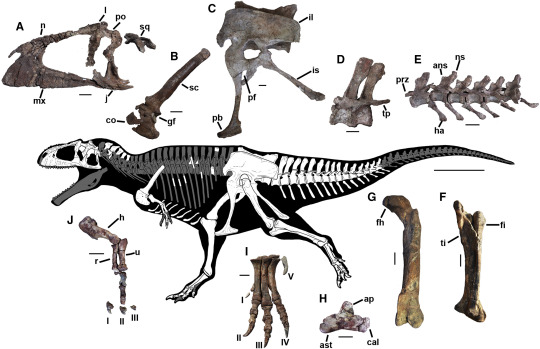
(Select bones and schematic skeletal of Meraxes gigas [scale bars = 10 cm for individual bones and 1 m for the skeletal], with preserved bones in white, from Canale et al., 2022)
Meaning of name: Meraxes = dragon character from the A Song of Ice and Fire novel series; gigas = giant [in Greek]
Age: Late Cretaceous (Cenomanian–Turonian)
Where found: Huincul Formation, Neuquén, Argentina
How much is known: Partial skeleton of one individual, including a nearly complete skull and limbs.
Notes: Meraxes was a carcharodontosaur, a group of large, carnivorous theropods that also includes Giganotosaurus and Acrocanthosaurus. It was probably closely related to other South American carcharodontosaurs like Giganotosaurus, Mapusaurus, and Tyrannotitan. These genera were among the largest known theropods, all of them (including Meraxes) having been estimated to have weighed over 4 tons.
Meraxes exhibits the most completely preserved skull and forelimbs of any Late Cretaceous carcharodontosaur discovered. Its forelimbs were greatly reduced in size, comparable in relative length to those of the famously short-armed tyrannosaurids. However, even though carcharodontosaurs had convergently evolved a similar body plan to tyrannosaurids, microscopic examination of their bone structure indicates that these two groups of large theropods grew in very different ways. Whereas giant tyrannosaurids reached their adult sizes by going through a growth spurt relatively early in life, Meraxes grew more slowly across a longer period of time. In fact, the type specimen of Meraxes is inferred to have been between 39–53 years old when it died, making it the oldest individual of a Mesozoic theropod known so far.
Reference: Canale, J.I., S. Apesteguía, P.A. Gallina, J. Mitchell, N.D. Smith, T.M. Cullen, A. Shinya, A. Haluza, F.A. Gianechini, and P.J. Makovicky. 2022. New giant carnivorous dinosaur reveals convergent evolutionary trends in theropod arm reduction. Current Biology advance online publication. doi: 10.1016/j.cub.2022.05.057
184 notes
·
View notes
Text
Ulughbegsaurus uzbekistanensis Tanaka et al., 2021 (new genus and species)
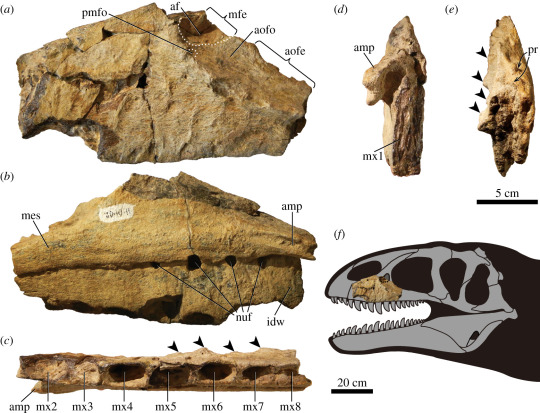
(Type maxilla [bone in the upper jaw] of Ulughbegsaurus uzbekistanensis, from Tanaka et al., 2021)
Meaning of name: Ulughbegsaurus = [Timurid sultan, astronomer, and mathematician] Ulugh Beg’s lizard; uzbekistanensis = from Uzbekistan
Age: Late Cretaceous (Turonian), about 90–92 million years ago
Where found: Bissekty Formation, Navoiy, Uzbekistan
How much is known: Several partial maxillae (bones in the upper jaw).
Notes: Ulughbegsaurus was a carcharodontosaur, a group of large, carnivorous theropods that also includes Giganotosaurus and Acrocanthosaurus. Estimated to have been 7.5–8 m long, Ulughbegsaurus was not one of the biggest carcharodontosaurs. However, it is the largest predator known from the Bissekty Formation, surpassing the size of tyrannosauroids and dromaeosaurids that have been previously described from the same horizon.
Reference: Tanaka, K., O.U.O. Anvarov, D.K. Zelenitsky, A.S. Ahmedshaev, and Y. Kobayashi. 2021. A new carcharodontosaurian theropod dinosaur occupies apex predator niche in the early Late Cretaceous of Uzbekistan. Royal Society Open Science 8: 210923. doi: 10.1098/rsos.210923
109 notes
·
View notes
Photo
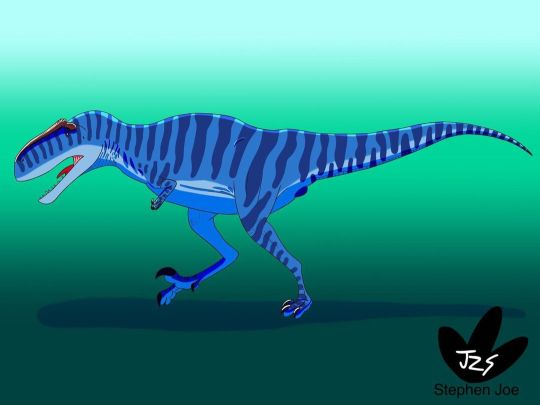
Beware of blue predatory Meraxes gigas. Is this the one with a sickle claw on its foot? Well yes. Could it be uses to pinning down its prey like both Dromaeosaurids and modern birds of prey? Probably not, it just rather be used for protection similar to cassowary when facing other foe. #sketchbookapp #paleoart #artistsoninstagram #myart #meraxes #meraxesgigas #giganotosaurini #carcharodontosauridae #allosauroidea #carnosauria #theropoda #dinosauria #dinosaur #theropoddinosaurs https://www.instagram.com/p/CgPQwemLiTe/?igshid=NGJjMDIxMWI=
#sketchbookapp#paleoart#artistsoninstagram#myart#meraxes#meraxesgigas#giganotosaurini#carcharodontosauridae#allosauroidea#carnosauria#theropoda#dinosauria#dinosaur#theropoddinosaurs
0 notes
Photo
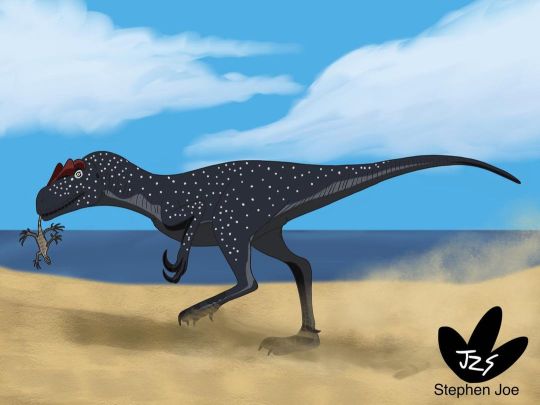
Day 19-20 of the week 4: Your favorite dinosaur (as a baby) A baby allosaurus europaeus, based on the incomplete skull as unnamed specie of the latter hatching. I just went to sketch, inked and painted my favorite theropoda allosaurus as baby, after I’m done this from last 2 weeks ago. #sketchbookapp #paleoart #myart #dinocember #dinocember2021 #allosaurus #allosauruseuropaeus #sketchbookappart #sketchbookappartist #allosauridae #allosauroidea #carnosauria #artistsoninstagram #dinosaur #dinosauria #theropoda #avetheropoda https://www.instagram.com/p/CXthy-JFguM/?utm_medium=tumblr
#sketchbookapp#paleoart#myart#dinocember#dinocember2021#allosaurus#allosauruseuropaeus#sketchbookappart#sketchbookappartist#allosauridae#allosauroidea#carnosauria#artistsoninstagram#dinosaur#dinosauria#theropoda#avetheropoda
0 notes